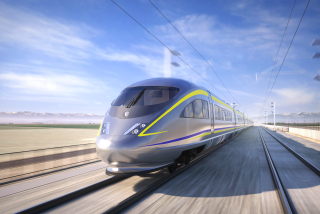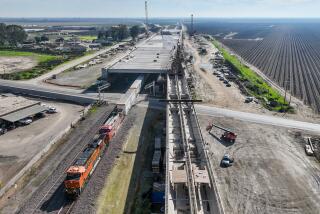Bullet train cost estimates rise to $98.5 billion
- Share via
California’s bullet train will cost an estimated $98.5 billion to build over the next 22 years, a price nearly double any previous projection and one likely to trigger political sticker shock, according to a business plan scheduled to be unveiled Tuesday.
In a key change, the state has decided to stretch out the construction schedule by 13 years, completing the Southern California-to-Bay Area high speed rail in 2033 rather than 2020.
The delay allows inflation to drive up the price over the additional years of construction.
The California High-Speed Rail Authority, the state agency running the project, plans to unveil the new business plan in a news conference Tuesday morning in Sacramento.
The authority’s past two plans have been sharply attacked, not only by opponents but also by many supporters, for offering unrealistic construction cost and ridership figures.
The new realism could bolster political support but also stoke opponents who say the system is unaffordable in the state’s current fiscal crisis.
The authority wants to begin construction next year and hopes to gain approval from the Legislature and Gov. Jerry Brown for appropriations from a bond issue that would build a $6.3-billion segment from Fresno to Bakersfield.
In the past, the California High Speed Rail Authority has estimated the cost of the system at $43 billion, based on finishing construction in 2020.
The system would run from downtown San Francisco through San Jose, Fresno, Bakersfield, Palmdale, and Los Angeles and end in Anaheim.
The higher costs projected in the new business plan result in part from the longer construction schedule and a higher estimate of future inflation. The authority is assuming inflation would average 3% per year through 2033, rather than the far more optimistic figure of less than 2% used earlier.
The price of the system has long been a moving target.
When the first business plan surfaced, it projected a $34-billion cost. By 2009, the estimate had jumped to $43 billion, in part because the authority included future inflation in the estimated cost of building the system over the next decade.
In August, the authority released two planning documents that signaled even higher costs. The cost of building only the first two segments in the Central Valley had jumped in price by as much as 100%, not including future inflation.
Unlike past business plans that have carried a single price, the new plan is expected to provide a variety of cost estimates that would run from an economy bullet train to a Cadillac model. But the range of financial options is likely to invite a new review of the project’s feasibility.
At least three outside groups, including the Office of Legislative Analyst, which provides nonpartisan advice to the Legislature, had estimated the true cost of the system at more than $65 billion. And rumors had circulated in recent weeks that the authority’s engineering contractors were warning that the cost could swell far higher, perhaps hitting $78 billion.
A stratospheric cost might be politically lethal, said Elizabeth Alexis, a co-founder of a citizen’s watchdog group that closely monitors the project.
Where the authority will come up with the money remains unclear. It has about $9 billion in state bonds it can tap and about $3 billion in federal grants. Congress, however, has dashed hopes of additional federal funds in the near future. Later this week, the authority is supposed to unveil a separate funding plan that must be approved by the Legislature before it can appropriate money to start construction.
The estimates being released Tuesday are expected to include cost-cutting proposals to incorporate the high-speed rail system into existing commuter rail track routes in both the Bay Area and Southern California, according to sources familiar with the plan. But such a change could extend bullet train travel times.
The new plan may also provide a shorter, lower-cost — and controversial — option to route the bullet train over the Interstate 5 and Grapevine corridor between Los Angeles and Bakersfield. The current plan includes a long dogleg to the east, through Palmdale, where officials have vowed to fight to maintain their connection to the project.
More to Read
Sign up for Essential California
The most important California stories and recommendations in your inbox every morning.
You may occasionally receive promotional content from the Los Angeles Times.














